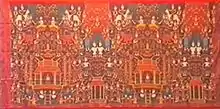
A pidan is a type of silk cloth used in Cambodian and Khmer weddings, funerals, and Buddhist ceremonies as a canopy or tapestry. Pidan are often decorated with images of wats, nāgas, apsaras, scenes from the life of Buddha, Angkor Wat, animals (especially elephants), and plants.[1]
Production
Pidan is produced by an experienced weaver. Because of this and it's silken composition, it is fairly expensive.[1]
History
Khmer textiles are a tradition dating back for over a millennium. As Cambodia had fallen under the governorship of French Indochina, pidan would begin to die. Then, in 1993, the Ministry of Culture and Fine Arts (Cambodia) revitalized the art of textile making among low-class artisans. This was to noticeable success.[2] Later, the Artists Association of Cambodia found success funding and keeping some businesses (and by extension the pidan) alive.[3]
Gallery
_from_Cambodia%252C_Khmer%252C_1880-1910.jpg.webp) Hol Pidan Khmer in 1880-1910 |
_from_Cambodia%252C_Khmer%252C_Honolulu_Museum_of_Art.jpg.webp) 19th century Hol Pidan Khmer in Honululu Museum of Art |
_LACMA_AC1996.17.1_(1_of_2).jpg.webp) 19th century Hol Pidan Khmer |
Further reading
References
- 1 2 Berthon, Magali. "HOL PIDAN: AN OTHERWORLDLY CAMBODIAN EXPERIENCE". Cooper Hewit. Retrieved 4 December 2021.
- ↑ Siyonda. "Abstract Part 3: Cambodian Textile and Khmer and Cham Culture". Institute for Khmer Traditional Textures. Retrieved 4 December 2021.
- ↑ "CAMBODIA'S HOL PIDAN WEAVING TRADITION — NEARLY LOST, NOW REVIVED". INDIGO LION HANDMADE. Retrieved 4 December 2021.